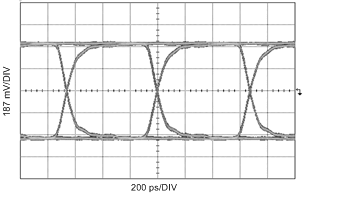SNLS285H April 2008 – May 2016 LMH0303
PRODUCTION DATA.
- 1 Features
- 2 Applications
- 3 Description
- 4 Revision History
- 5 Pin Configuration and Functions
- 6 Specifications
- 7 Detailed Description
- 8 Application and Implementation
- 9 Power Supply Recommendations
- 10Layout
- 11Device and Documentation Support
- 12Mechanical, Packaging, and Orderable Information
Package Options
Mechanical Data (Package|Pins)
- RUM|16
Thermal pad, mechanical data (Package|Pins)
- RUM|16
Orderable Information
6 Specifications
6.1 Absolute Maximum Ratings
over operating free-air temperature range (unless otherwise noted)(1)| MIN | MAX | UNIT | ||
|---|---|---|---|---|
| Supply voltage | –0.5 | 3.6 | V | |
| Input voltage (all inputs) | –0.3 | VCC + 0.3 | V | |
| Output current | 28 | mA | ||
| Lead temperature (soldering, 4 s) | 260 | °C | ||
| Junction temperature | 125 | °C | ||
| Storage temperature, Tstg | –65 | 150 | °C | |
(1) Stresses beyond those listed under Absolute Maximum Ratings may cause permanent damage to the device. These are stress ratings only, which do not imply functional operation of the device at these or any other conditions beyond those indicated under Recommended Operating Conditions. Exposure to absolute-maximum-rated conditions for extended periods may affect device reliability.
6.2 ESD Ratings
| VALUE | UNIT | |||
|---|---|---|---|---|
| V(ESD) | Electrostatic discharge | Human-body model (HBM), per ANSI/ESDA/JEDEC JS-001(1) | ±8000 | V |
| Charged-device model (CDM), per JEDEC specification JESD22-C101(2) | ±2000 | |||
| Machine model (MM) | ±400 | |||
(1) JEDEC document JEP155 states that 500-V HBM allows safe manufacturing with a standard ESD control process. Pins listed as
±8000 V may actually have higher performance.
±8000 V may actually have higher performance.
(2) JEDEC document JEP157 states that 250-V CDM allows safe manufacturing with a standard ESD control process. Pins listed as
±2000 V may actually have higher performance.
±2000 V may actually have higher performance.
6.3 Recommended Operating Conditions
over operating free-air temperature range (unless otherwise noted)| MIN | NOM | MAX | UNIT | |
|---|---|---|---|---|
| Supply voltage (VCC – VEE) | 3.13 | 3.3 | 3.46 | V |
| Operating junction temperature | 100 | °C | ||
| Operating free air temperature, TA | –40 | 25 | 85 | °C |
6.4 Thermal Information
| THERMAL METRIC(1) | LMH0303 | UNIT | |
|---|---|---|---|
| RUM (WQFN) | |||
| 16 PINS | |||
| RθJA | Junction-to-ambient thermal resistance | 40.7 | °C/W |
| RθJC(top) | Junction-to-case (top) thermal resistance | 39.5 | °C/W |
| RθJB | Junction-to-board thermal resistance | 18.5 | °C/W |
| ψJT | Junction-to-top characterization parameter | 0.6 | °C/W |
| ψJB | Junction-to-board characterization parameter | 18.5 | °C/W |
| RθJC(bot) | Junction-to-case (bottom) thermal resistance | 8 | °C/W |
(1) For more information about traditional and new thermal metrics, see the Semiconductor and IC Package Thermal Metrics application report, SPRA953.
6.5 Electrical Characteristics – DC
Over supply voltage and operating temperature ranges (unless otherwise noted)(1)(2)| PARAMETER | TEST CONDITIONS | MIN | TYP | MAX | UNIT | |
|---|---|---|---|---|---|---|
| VCMIN | Input common mode voltage | SDI, SDI | 1.6 + VSDI/2 | VCC – VSDI/2 | V | |
| VSDI | Input voltage swing | Differential (SDI, SDI) | 100 | 2200 | mVP−P | |
| VCMOUT | Output common mode voltage | SDO, SDO | VCC – VSDO | V | ||
| VSDO | Output voltage swing (SDO, SDO) | Single-ended, 75-Ω load, RREF = 750 Ω 1% |
720 | 800 | 880 | mVP-P |
| VIH | Input voltage high level | SD/HD, ENABLE | 2 | V | ||
| VIL | Input voltage low level | SD/HD, ENABLE | 0.8 | V | ||
| ICC | Supply current | SD/HD = 0, SDO/SDO enabled |
47 | 57 | mA | |
| SD/HD = 1, SDO/SDO enabled |
40 | 47 | ||||
| SDO/SDO disabled | 1.3 | 2.5 | ||||
| SMBUS DC SPECIFICATIONS | ||||||
| VSIL | Data, clock input low voltage | 0.8 | V | |||
| VSIH | Data, clock input high voltage | 2.1 | VSDD | V | ||
| ISPULLUP | Current through pullup resistor or current source |
VOL = 0.4 V | 4 | mA | ||
| VSDD | Nominal bus voltage | 3 | 3.6 | V | ||
| ISLEAKB | Input leakage per bus segment(3) | –200 | 200 | µA | ||
| ISLEAKP | Input leakage per pin | –10 | 10 | µA | ||
| CSI | Capacitance for SDA and SCL(3)(4) | 10 | pF | |||
(1) Current flow into device pins is defined as positive. Current flow out of device pins is defined as negative. All voltages are stated referenced to VEE = 0 V.
(2) Typical values are stated for VCC = 3.3 V and TA = 25°C.
(3) Recommended value — Parameter not tested.
(4) Recommended maximum capacitive load per bus segment is 400 pF.
6.6 Electrical Characteristics – AC
Over supply voltage and operating temperature ranges (unless otherwise noted)(1)| PARAMETER | TEST CONDITIONS | MIN | TYP | MAX | UNIT | |
|---|---|---|---|---|---|---|
| DRSDI | Input data rate | 2970 | Mbps | |||
| Tjit | Additive output jitter | 2.97 Gbps | 20 | psP-P | ||
| 1.485 Gbps | 18 | |||||
| 270 Mbps | 15 | |||||
| tr,tf | Output rise time and fall time | SD/HD = 0, 20% to 80% | 90 | 130 | ps | |
| SD/HD = 1, 20% to 80% | 400 | 800 | ||||
| TMATCH | Mismatch in rise or fall time | SD/HD = 0 | 30 | ps | ||
| SD/HD = 1 | 50 | |||||
| TDCD | Duty cycle distortion | SD/HD = 0, 2.97 Gbps(2) | 27 | ps | ||
| SD/HD = 0, 1.485 Gbps(2) | 30 | |||||
| SD/HD = 1(2) | 100 | |||||
| TOS | Output overshoot | SD/HD = 0(2) | 10% | |||
| SD/HD = 1(2) | 8% | |||||
| RLSDO | Output return loss | 5 MHz to 1.5 GHz(3) | 15 | dB | ||
| 1.5 GHz to 3 GHz(3) | 10 | |||||
(1) Typical values are stated for VCC = 3.3 V and TA = 25°C.
(2) Specification is ensured by characterization.
(3) Output return loss is dependent on board design. The LMH0303 meets this specification on the SD303EVK evaluation board.
6.7 Timing Requirements
| MIN | NOM | MAX | UNIT | ||
|---|---|---|---|---|---|
| fSMB | Bus operating frequency | 10 | 100 | kHz | |
| tBUF | Bus free time between stop and start condition | 4.7 | µs | ||
| tHD:STA | Hold time after (repeated) start condition. After this period, the first clock is generated; at ISPULLUP = MAX |
4 | µs | ||
| tSU:STA | Repeated start condition setup time | 4.7 | µs | ||
| tSU:STO | Stop condition setup time | 4 | µs | ||
| tHD:DAT | Data hold time | 300 | ns | ||
| tSU:DAT | Data setup time | 250 | ns | ||
| tLOW | Clock low period | 4.7 | µs | ||
| tHIGH | Clock high period | 4 | 50 | µs | |
| tF | Clock or data fall time | 300 | ns | ||
| tR | Clock or data rise time | 1000 | ns | ||
| tPOR | Time in which device must be operational after power on | 500 | ms | ||
 Figure 1. SMBus Timing Parameters
Figure 1. SMBus Timing Parameters
6.8 Typical Characteristics
Typical device characteristics at TA = 25°C and VCC = 3.3 V (unless otherwise noted) Figure 2. SDO PRBS10 at 2.97 Gbps
Figure 2. SDO PRBS10 at 2.97 Gbps
 Figure 3. SDO PRBS10 at 1.485 Gbps
Figure 3. SDO PRBS10 at 1.485 Gbps